Questions and Answers: February 2015
This is one of the most popular parts of e-gardens, and we encourage you to send your questions to Neil. He does require a photo before he can use your question, and he chooses questions that will be of the greatest interest to our readers. It helps him give a far more precise response if you’ll also tell him where you are gardening.
That said, here are this month’s questions and Neil’s replies.
Question: Is there anything I can do to cover these roots at the surface of the soil? They’re of some type of large elm tree, and they are hazards for tripping. C.B., Farmers Branch.
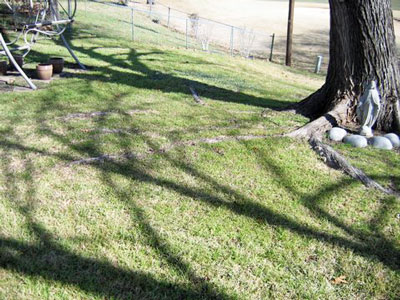
Answer: These look like roots of an American elm, and that’s exactly how they develop. When I tell people that 90 percent of a tree’s roots are in the top foot of soil, it’s trees like this that prove that best. Covering the roots won’t help, because they will merely grow larger and resurface later. Plus you’d be left with a very uneven patch of ground. You could remove one root per year, preferably in October or November to allow the tree time to regrow as many roots as possible. I have a couple of native American elms that have the same surface roots, and I’ve just learned to avoid them.
Question: Our St. Augustine has another grass that is slowly and persistently invading and expanding. It grows low, like our St. Augustine does, but it’s noticeable, especially in winter. What is it, and what can be done to eliminate it? Should I just dig it up? T.G., Keller.
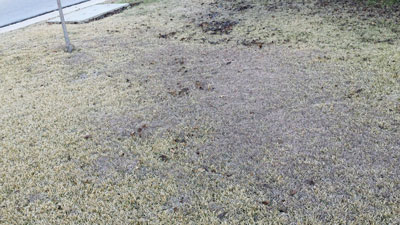
Answer: This looks like it might be bahiagrass, and there is no herbicide that will kill it without harming your St. Augustine. Your best bet will be to wait until it greens up and is growing vigorously late this spring, then spray with a glyphosate-only herbicide, taking care that it only get onto the bahia. Glyphosates do not contaminate the soil, so you would be able to replant St. Augustine sod or plugs into the soil just a week or two later. Digging out the clumps by hand is an option, but you’ll have to be diligent to continue digging as new clumps emerge from the pieces you missed.
Question: I have several ornamental grasses that have developed dead spots in their middles. Is this natural, or am I doing something wrong? What can I do now? No name given, Altoga.
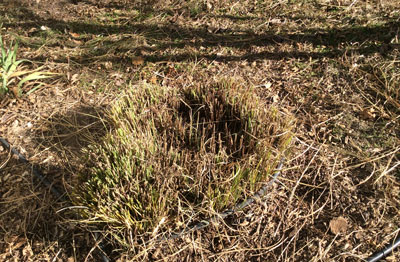
Answer: I’m guessing this is a planting of maidengrass. Many of the ornamental grasses tend to spread from their original clumps, with the mother clump dying out in the process. That means that we need to dig and divide the vigorous new clumps, redo the soil in the bed as we also remove the dead stubble, then replant. February would be a good time to do so.
Question: We planted Japanese aralias, but this one seems to be yellowing. What caused it, and what should I do to stop it? T.G., Keller.
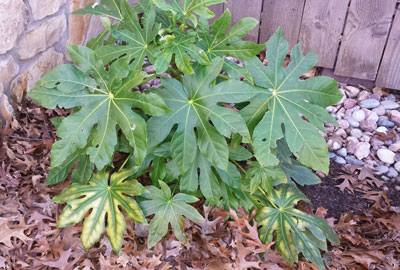
Answer: The worst leaves seem to be at the bottom, which is just fine. They would have been shed by mid-spring, as new growth begins. That’s a fairly normal sequence. I do see a bit of yellowing in one or two of the upper leaves. That might suggest slightly too much sun or slightly too little water at some point. Aralias have a smaller “margin of error” than many of our other shrubs.
Question: I’ve been reading a lot about rose rosette virus attacking roses. These are Drift roses, and they had a growth spurt last fall, but the flowers never developed properly. How can I be sure if my roses have the disease? S., Frisco.
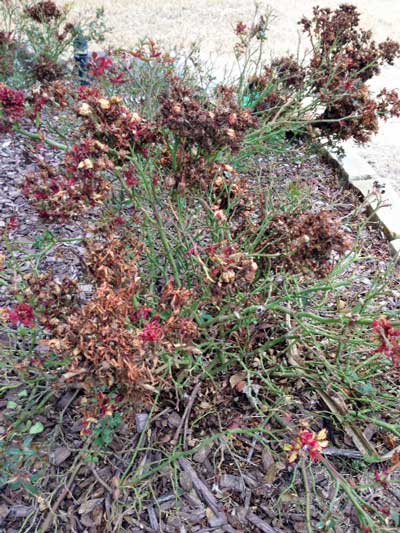
Answer: First, rose rosette is epidemic across your city (as opposed to other parts of Texas), so your odds are greatly increased. Affected canes are vastly different in appearance. Buds do not develop properly, and the canes will have many times more thorns. Since it is a virus that is spread by microscopic mites, there is no control. Affected plants should be removed entirely, roots and all. I’ll be posting more information on RRV in upcoming issues of e-gardens, on my website and on my Facebook page.
Question: I am finally getting my siding replaced and will be able to do my foundation plantings this spring. I’m trying to balance out my oddly shaped gables. I think the area to the right of the front sidewalk and steps needs a shrub. I’m considering either a podocarpus or an Oakleaf holly. The area faces northwest. It will get afternoon sun. Any suggestions? D., Fort Worth.

Answer: I love podocarpus, but they’re not easily grown in DFW. Oakleaf (or the very similar Oakland) hollies are super stars in my gardens. One of them would be perfect. So would weeping yaupon, if you wanted a bit of a different look.
Question: I have a palm indoors. Its leaves are being devoured, but I have no idea what could be doing the damage. Suggestions? A.H., no city given.
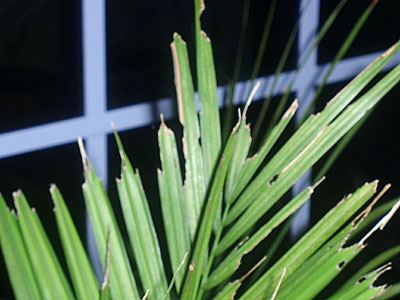
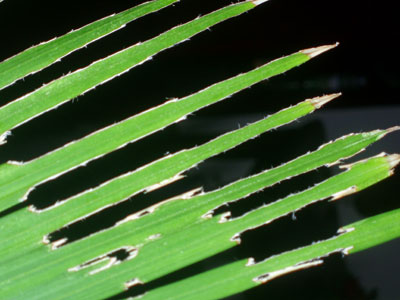
Answer: Wow! Beats me. I have never seen an insect pest do that to any foliage plant indoors. It looks for all the world like grasshopper damage. If the plant was outdoors for a period of time, that would be my guess. It all appears to have been done about the same time in the past, so watch the new growth. Perhaps the pest is gone.
Question: My peach tree was damaged badly by hail last spring. Now it looks really rough. Is there anything I can do now to overcome the problem? No name given, Altoga.
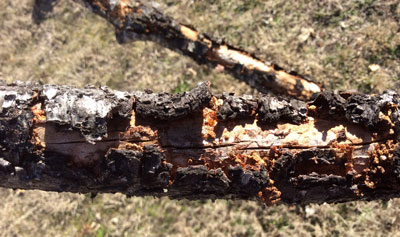
Answer: This is looking really brutalized. Because the limb is actually splitting, I’d be concerned that this part of the tree has dried out and died completely. The limb will probably need to be removed. Hopefully other branches won’t be impacted so badly. There was nothing you could have done to prevent this, and there is nothing you can do now to help the tree heal, other than giving it a steady supply of moisture. Good luck!
Question: Mushrooms have started popping up in my buffalograss lawn. It’s only in this one section of the lawn. Should I be concerned? T.W., Leonard.
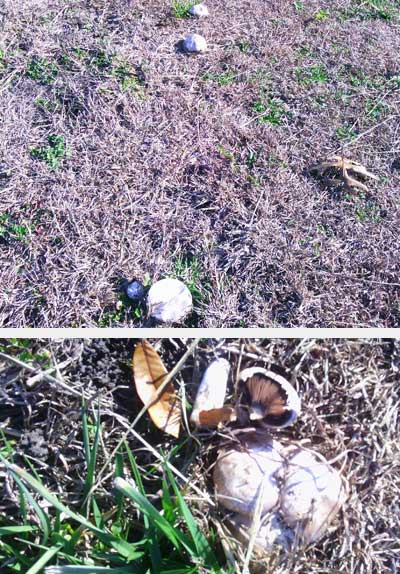
Answer: They are absolutely of no concern. They are living off the decaying organic matter in the soil. They will soon be gone and may never reappear.
Question: I have given up planting flowers in my beds. Rabbits just eat them off. I went to containers, some even on legs, but something is still chewing them. Would rabbits jump into these pots? L.R., Allen.

Answer: I’ve never seen rabbits jump into pots, especially those like the ones you are using. It might be birds, squirrels or mice, or it could be snails during the warm spells. I wouldn’t give up on using the pots just yet. Keep a close watch, and perhaps you’ll be able to see what the culprit might be.
Question: We have battled what we thought was chinch bugs in our St. Augustine lawn for 13 years. The damage is routinely in the hottest and sunniest part of our St. Augustine lawn, which we have replaced completely once. Last summer we treated three times for chinch bugs, and it didn’t seem to help at all. What can we do heading into this lawn-care season? (Photo taken in December.) No name given., Arlington.
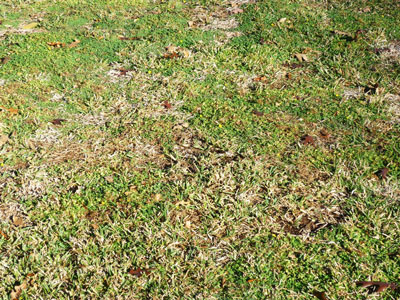
Answer: Your description and timing are spot-on for chinch bugs. The best control is the insecticide Imidacloprid, applied just as the damage first begins to be evident (grass that is beginning to wilt and fold, but before it turns brown). Check the perimeter of the affected areas for the BB-sized black insects (white diamonds on their backs). If you don’t find them, don’t apply the insecticide. At that point, send another photo of the situation. Try as I will, I can’t tell from your photo taken several months after the fact.
